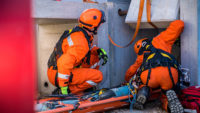Keeping workers safe is a priority for healthcare facilities year-round, but cold temperatures and winter storms present new considerations for managing workplace hazards. Even in regions that traditionally experience milder winter weather conditions, changing climate patterns are leading to deep freezes and snowstorms that disrupt operations and lead to increased safety risks.
This winter, warm ocean water in the Pacific is creating a strong El Niño pattern, which is expected to cause unpredictable weather across the U.S. To prepare for this uncertainty, facility leaders need to have a thorough strategy in place to support their teams when responding to any situation. Training employees, assessing risk factors and proactive emergency planning are all essential aspects to ensure the facility workplace environment remains safe throughout the upcoming season.
Train employees in hazard and emergency response
Winter safety planning efforts are futile unless all workers understand how to remain compliant and execute response tactics. Targeted instructions and resources are crucial for maintaining a safe physical environment during harsh winter conditions. Effective training programs build up the team’s ability and willingness to proactively respond to issues.
For facility teams in southern states, leaders will need to devote special attention to educating workers who are not accustomed to below-freezing temperatures or snow accumulation. These employees are less familiar with tactics to prevent cold stress, which leads to frostbite and hypothermia. Any team members working outside will need to know how to stay warm and recognize warning signs of losing body heat.
The most effective way to ensure workers are following through on guidance is to establish a culture of compliance and integrate safety protocols into daily operations. This starts by connecting with the team to define clear expectations and convey why and how following protocol will prevent harm.
Understand your facility’s unique risk factors
Depending on the region, health systems will need to prepare for various scenarios that may occur. While Northeastern and Midwestern healthcare teams are accustomed to snow and ice, it’s become apparent in recent years that facilities in states like Texas and Florida need to prioritize climate resiliency and establish thorough plans to protect employees during severe winter weather. In facilities that are not built to withstand the cold, workers may need to be prepared to respond to doors freezing open, pipes bursting and more.
Conducting winter risk assessments allows healthcare leaders to identify top hazards to address, which can include hypothermia, downed power lines, slippery surfaces and more. With general fall protection topping OSHA’s list of most common violations in 2022, leaders must implement tactics to prevent slips and falls caused by ice or snow near the entryways of their facilities.
Address emergency needs proactively
An effective winter preparedness strategy supports the team to confidently and safely respond to emergencies. Although every situation is unique, employees should be able to start with the consistent procedures of the all-hazards plan, which overviews standardized procedures for the early stages of any crisis. The plan can help to determine the level of response needed given the circumstance and resources on hand.
During the preparation stages, leaders will need to consider solutions for all issues that may cause disruptions for their teams. For example, to promote safe commutes on icy roads or during snowstorms, OSHA recommends urging workers to drive cautiously and ensuring all facility access points are clear of snow and salted when needed.
Leaders should also consider how to determine when facility evacuation is necessary to keep their teams safe. One useful strategy is to partner with a private meteorology service provider that can provide detailed information on the severity and precise location of incoming weather.
Maintaining a safe workplace environment during winter requires more purposeful planning to prevent seasonal hazards. When teams are aware of the risks present and how to mitigate them, they are able to maintain operations throughout the season while avoiding harm.


